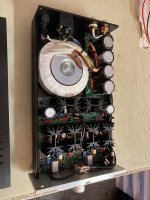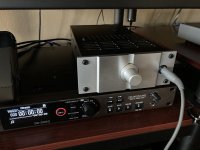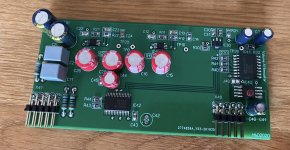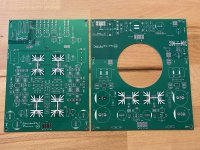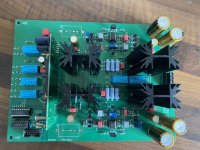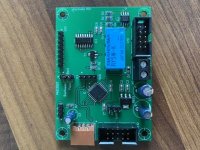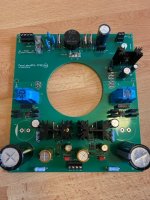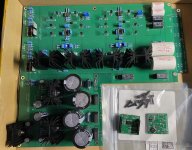I am a complete noob. Is it feasible to power a pair of bookshelf speakers directly with
a reasonable amount of modifications?
a reasonable amount of modifications?
The HPA-1 can be used as a line stage. In that case it could be used before a very good power amp to power some speakers. Regarding modifications to the original design, anything that is changed will affect the sound (likely not for the better), including using a different size and or type of power transformer. Just sayin' 🙂
I am a complete noob. Is it feasible to power a pair of bookshelf speakers directly with
a reasonable amount of modifications?
It will make sound. But it won't have a whole lot of wattage of class A operating range. But it will work if 1 watt-ish is enough for you.
I will give you a hint though...the "Cubie" series of amps by Juma (search "Cubie" in the pass forum) are very, very close to a power amp version of the HPA-1.
Thanks for the tips! I'll check out the Cubie and keep lurking around before I decide what to start 😉
I started out looking at something like Cubie for an HPA-1-inspired power amp, but Jam encouraged me to go in a different direction. You can read all about it here: JamJar: an HPA-1-inspired power amp.
Miniature version
I completed my smaller version. It is pretty crowded but I managed to fit it all into a chassis with inside dimensions of 135 x 250 x 48mm (W x L x H). I had to use a few SMT devices on the relay turn on delay circuit, but the rest of the circuit is through hole. The height limitation meant I had to reduce the filter caps from 4 x 10,000uF to 4 x 6800uF. The transformer is a 50VA medical version with extra shielding. There is no noise or hum at all.
With the heat sinks I could fit in the case, the temperature on the sinks is about 60C with the 100mA bias. But I found that I could safely reduce the bias current since my headphones are AKG K701s. They are 63 Ohm and max out at 200mW. That means I only need 80mA peak to drive them to the limits. So I could get by with as little as 40mA bias and still be class A. Of course reducing the bias that low started to affect the distortion. But I found a sweet spot with the bias at 60 mA. This actually resulted in lower distortion at the levels I was interested in than the full 100mA bias. This keeps the heat sinks at about 50C. I cut ventilation slots in the cover and things stay pretty cool. I intentionally did not add ventilation slots near the front end components and there doesn't seem to be any sensitivity to breezes on the bias or offset.
Overall I am very happy with the performance. The BW is about 1250 kHz (-3dB). Noise is below what I can measure or hear. The 10kHz square wave looks great.
Distortion (using my HP 339A) is very low:
1V 1KHz = .0034%
1V 20kHz = .0046%
It is getting pretty close to the residual of the analyzer.
The little bit of listening I have done so far has been really pleasing.
I completed my smaller version. It is pretty crowded but I managed to fit it all into a chassis with inside dimensions of 135 x 250 x 48mm (W x L x H). I had to use a few SMT devices on the relay turn on delay circuit, but the rest of the circuit is through hole. The height limitation meant I had to reduce the filter caps from 4 x 10,000uF to 4 x 6800uF. The transformer is a 50VA medical version with extra shielding. There is no noise or hum at all.
With the heat sinks I could fit in the case, the temperature on the sinks is about 60C with the 100mA bias. But I found that I could safely reduce the bias current since my headphones are AKG K701s. They are 63 Ohm and max out at 200mW. That means I only need 80mA peak to drive them to the limits. So I could get by with as little as 40mA bias and still be class A. Of course reducing the bias that low started to affect the distortion. But I found a sweet spot with the bias at 60 mA. This actually resulted in lower distortion at the levels I was interested in than the full 100mA bias. This keeps the heat sinks at about 50C. I cut ventilation slots in the cover and things stay pretty cool. I intentionally did not add ventilation slots near the front end components and there doesn't seem to be any sensitivity to breezes on the bias or offset.
Overall I am very happy with the performance. The BW is about 1250 kHz (-3dB). Noise is below what I can measure or hear. The 10kHz square wave looks great.
Distortion (using my HP 339A) is very low:
1V 1KHz = .0034%
1V 20kHz = .0046%
It is getting pretty close to the residual of the analyzer.
The little bit of listening I have done so far has been really pleasing.
Attachments
Very nice build.
I go another way with a two board version.
PSU with HF/DC filter and active rectifier.
Amp with Muses Volume, up to three input channels and microcontroller control unit.
Jeff: thanks for sharing
I go another way with a two board version.
PSU with HF/DC filter and active rectifier.
Amp with Muses Volume, up to three input channels and microcontroller control unit.
Jeff: thanks for sharing
Meldano, Terry,
Impressive builds guys. I am amazed at the amount of time and care you have put into the project. Bravo!
Jeff looks that you have some competition. 😀
Terry, the distortion usually is about 0.0025% at those levels which is affected by bias and some degree by rail voltage. The target I set for was 50 degrees C on the output heat sinks which was about 100mA per channel. Second harmonic was slightly higher than third, if I recall correctly.
You can lower distortion by increasing the amount of feedback but that usually causes a decrease in sound fidelity.
Jam
Impressive builds guys. I am amazed at the amount of time and care you have put into the project. Bravo!
Jeff looks that you have some competition. 😀
Terry, the distortion usually is about 0.0025% at those levels which is affected by bias and some degree by rail voltage. The target I set for was 50 degrees C on the output heat sinks which was about 100mA per channel. Second harmonic was slightly higher than third, if I recall correctly.
You can lower distortion by increasing the amount of feedback but that usually causes a decrease in sound fidelity.
Jam
Attachments
Jam,
The distortion is plenty low enough. The sound is great. Distortion is primarily second harmonic. I played with the bias while looking at distortion versus frequency and output level using a 60 ohm load. I found that I got slightly lower distortion at 60 mA at levels below about 3vrms. At higher levels it was better with the 100mA bias. But my headphones would go up in smoke at those levels. No doubt other headphones, especially lower Z ones will benefit from the higher bias setting. But it was nice to see that I could get good results in the small enclosure I picked and keep the sinks at 50C. I picked the enclosure simply because the front panel matched the look of my Pass Labs amp and preamplifier. Then i set out to see if I could fit the circuit into the small enclosure. Definitely not the recommended way to approach the design. But it was a fun challenge and that’s why it is a hobby. Having to reduce the transformer size and the bulk filter capacitance was the only compromise I had to make. I was worried about having the transformer so close to the circuitry. But I was pleased that the result is still perfectly quiet.
The distortion is plenty low enough. The sound is great. Distortion is primarily second harmonic. I played with the bias while looking at distortion versus frequency and output level using a 60 ohm load. I found that I got slightly lower distortion at 60 mA at levels below about 3vrms. At higher levels it was better with the 100mA bias. But my headphones would go up in smoke at those levels. No doubt other headphones, especially lower Z ones will benefit from the higher bias setting. But it was nice to see that I could get good results in the small enclosure I picked and keep the sinks at 50C. I picked the enclosure simply because the front panel matched the look of my Pass Labs amp and preamplifier. Then i set out to see if I could fit the circuit into the small enclosure. Definitely not the recommended way to approach the design. But it was a fun challenge and that’s why it is a hobby. Having to reduce the transformer size and the bulk filter capacitance was the only compromise I had to make. I was worried about having the transformer so close to the circuitry. But I was pleased that the result is still perfectly quiet.
Terry,
Your results are great, the numbers I quoted are from a stock unit with matched j-fets after 24 hr warm up. You are well within the window.
I designed the unit to drive a wide a range of headphone types as possible, which is an interesting problem as there is a conflict in requirements - hi or low impedance.
I am working on a new design which will have a balanced input and a different topology and regulators but retain the use of current mirrors.
Jam
Your results are great, the numbers I quoted are from a stock unit with matched j-fets after 24 hr warm up. You are well within the window.
I designed the unit to drive a wide a range of headphone types as possible, which is an interesting problem as there is a conflict in requirements - hi or low impedance.
I am working on a new design which will have a balanced input and a different topology and regulators but retain the use of current mirrors.
Jam
Jam,
I see how impossible the requirements for high and low impedance phones impose on a ‘universal’ headphone amp must be. The HPA-1 does an incredible job. Narrowing the target to 60 Ohm phones at less than 3vrms made it possible for me to fit into a smaller enclosure, but even then I had to compromise a little on the power sections. I also simplified the input selection circuitry since I only wanted a headphone amp, not a preamp. So I only used a 20 second turn on delay circuit, without the additional input selection circuitry.
The sound exceeds my expectations. I can’t imagine a better sounding amp for my K701s. The circuit is very stable. It would be perfectly acceptable without the DC servo, but the servo works so well that there was no reason to leave it out.
The gain is a little low for my system. I have a Pass Labs X2.5 pre driving an X350.5 amp. I use the balanced output of the pre to drive the amp and the unbalanced output to drive the headphone amp. I have to crank the preamp volume much higher for the headphones than for the amp. No problem, but it would be cool if they were better matched. If I ever turned on the amp at the level I use for listening through the headphones it would blow the windows out of my house. But increasing the gain would likely ruin the sound character of it is not an option.
I’m already considering a larger version so that I wouldn’t have to compromise at all on the power supply or bias.
Thanks so much for this wonderful design.
I see how impossible the requirements for high and low impedance phones impose on a ‘universal’ headphone amp must be. The HPA-1 does an incredible job. Narrowing the target to 60 Ohm phones at less than 3vrms made it possible for me to fit into a smaller enclosure, but even then I had to compromise a little on the power sections. I also simplified the input selection circuitry since I only wanted a headphone amp, not a preamp. So I only used a 20 second turn on delay circuit, without the additional input selection circuitry.
The sound exceeds my expectations. I can’t imagine a better sounding amp for my K701s. The circuit is very stable. It would be perfectly acceptable without the DC servo, but the servo works so well that there was no reason to leave it out.
The gain is a little low for my system. I have a Pass Labs X2.5 pre driving an X350.5 amp. I use the balanced output of the pre to drive the amp and the unbalanced output to drive the headphone amp. I have to crank the preamp volume much higher for the headphones than for the amp. No problem, but it would be cool if they were better matched. If I ever turned on the amp at the level I use for listening through the headphones it would blow the windows out of my house. But increasing the gain would likely ruin the sound character of it is not an option.
I’m already considering a larger version so that I wouldn’t have to compromise at all on the power supply or bias.
Thanks so much for this wonderful design.
- Home
- Amplifiers
- Pass Labs
- Pass HPA-1, what do we know?
